Provläsningsexemplar / Preview
INTERNATIONAL
STANDARD
ISO
13400-2
First edition
2012-06-01
Road vehicles — Diagnostic
communication over Internet Protocol
(DoIP) —
Part 2:
Transport protocol and network layer
services
Véhicules routiers — Communication de diagnostic au travers du
protocole internet (DoIP) —
Partie 2: Protocole de transport et services de la couche réseau
Reference number
ISO 13400-2:2012(E)
© ISO 2012
�
ISO 13400-2:2012(E)
Provläsningsexemplar / Preview
COPYRIGHT PROTECTED DOCUMENT
ISO 2012
©
All rights reserved. Unless otherwise specified, no part of this publication may be reproduced or utilized in any form or by any means,
electronic or mechanical, including photocopying and microfilm, without permission in writing from either ISO at the address below or ISO’s
member body in the country of the requester.
ISO copyright office
Case postale 56 • CH-1211 Geneva 20
Tel. + 41 22 749 01 11
Fax + 41 22 749 09 47
E-mail copyright@iso.org
Web www.iso.org
Published in Switzerland
ii
© ISO 2012 – All rights reserved
�
Provläsningsexemplar / Preview
ISO 13400-2:2012(E)
Page
Contents
Foreword ............................................................................................................................................................................iv
Introduction ........................................................................................................................................................................ v
Scope ...................................................................................................................................................................... 1
1
Normative references ......................................................................................................................................... 1
2
Terms, definitions, symbols and abbreviated terms .................................................................................. 2
3
Terms and definitions ......................................................................................................................................... 2
3.1
Symbols ................................................................................................................................................................. 3
3.2
3.3
Abbreviated terms ............................................................................................................................................... 4
Conventions .......................................................................................................................................................... 5
4
Document overview ............................................................................................................................................ 5
5
Basic requirements for implementation of internet protocols ................................................................ 7
6
General considerations ..................................................................................................................................... 7
6.1
Network layer requirements ............................................................................................................................. 8
6.2
Transport Layer requirements ......................................................................................................................... 9
6.3
6.4
Application layer requirements — Dynamic host control protocol (DHCP) ......................................14
Application layer requirements — Data transmission order .................................................................18
6.5
DoIP protocol — Technical description .......................................................................................................19
7
IP-based vehicle communication protocol .................................................................................................19
7.1
7.2
Socket handling .................................................................................................................................................41
Timing and communication parameters .....................................................................................................48
7.3
Logical addressing ...........................................................................................................................................49
7.4
7.5
Communication environments and recommended timings ..................................................................50
Transport layer services ..................................................................................................................................50
8
General information ..........................................................................................................................................50
8.1
Specification of DoIP layer service primitives ...........................................................................................52
8.2
8.3
Service data unit specification ......................................................................................................................53
DoIP protocol usage .........................................................................................................................................54
9
General information ..........................................................................................................................................54
9.1
Connection establishment and vehicle discovery ...................................................................................54
9.2
9.3
DoIP session .......................................................................................................................................................56
Vehicle network integration ............................................................................................................................58
9.4
DoIP entity functional requirements ............................................................................................................64
10
Communication example message sequence charts ..............................................................................64
11
Bibliography .....................................................................................................................................................................67
© ISO 2012 – All rights reserved
iii
�
Provläsningsexemplar / Preview
ISO 13400-2:2012(E)
Foreword
ISO (the International Organization for Standardization) is a worldwide federation of national standards bodies
(ISO member bodies). The work of preparing International Standards is normally carried out through ISO
technical committees. Each member body interested in a subject for which a technical committee has been
established has the right to be represented on that committee. International organizations, governmental and
non-governmental, in liaison with ISO, also take part in the work. ISO collaborates closely with the International
Electrotechnical Commission (IEC) on all matters of electrotechnical standardization.
International Standards are drafted in accordance with the rules given in the ISO/IEC Directives, Part 2.
The main task of technical committees is to prepare International Standards. Draft International Standards
adopted by the technical committees are circulated to the member bodies for voting. Publication as an
International Standard requires approval by at least 75 % of the member bodies casting a vote.
Attention is drawn to the possibility that some of the elements of this document may be the subject of patent
rights. ISO shall not be held responsible for identifying any or all such patent rights.
ISO 13400-2 was prepared by Technical Committee ISO/TC 22, Road vehicles, Subcommittee SC 3, Electrical
and electronic equipment.
ISO 13400 consists of the following parts, under the general title Road vehicles — Diagnostic communication
over Internet Protocol (DoIP):
— Part 1: General information and use case definition
— Part 2: Transport protocol and network layer services
— Part 3: Wired vehicle interface based on IEEE 802.3
The following parts are under preparation:
— Part 4: Ethernet diagnostic connector
— Part 5: Conformance test specification
iv
© ISO 2012 – All rights reserved
�
Provläsningsexemplar / Preview
ISO 13400-2:2012(E)
Introduction
Vehicle diagnostic communication has been developed starting with the introduction of the first legislated
emissions-related diagnostics and has evolved over the years, now covering various use cases ranging
from emission-related diagnostics to vehicle-manufacturer-specific applications like calibration or electronic
component software updates.
With the introduction of new in-vehicle network communication technologies, the interface between the
vehicle’s electronic control units and the external test equipment has been adapted several times to address
the specific characteristics of each new network communication technology requiring optimized data link
layer definitions and transport protocol developments in order to make the new in-vehicle networks usable for
diagnostic communication.
With increasing memory size of electronic control units, the demand to update this increasing amount of software
and an increasing number of functions provided by these control units, technology of the connecting network
and buses has been driven to a level of complexity and speed similar to computer networks. New applications
(x-by-wire, infotainment) require high band-width and real-time networks (like FlexRay, MOST), which cannot
be adapted to provide the direct interface to a vehicle. This requires gateways to route and convert messages
between the in-vehicle networks and the vehicle interface to external test equipment.
The intent of ISO 13400 (all parts) is to describe a standardized vehicle interface which
— separates in-vehicle network technology from the external test equipment vehicle interface requirements
to allow for a long-term stable external vehicle communication interface,
— utilizes existing industry standards to define a long-term stable state-of-the-art communication standard
usable for legislated diagnostic communication as well as for manufacturer-specific use cases, and
— can easily be adapted to new physical and data link layers, including wired and wireless connections, by
using existing adaptation layers.
To achieve this, all parts of ISO 13400 are based on the Open Systems Interconnection (OSI) Basic Reference
Model specified in ISO/IEC 7498-1 and ISO/IEC 10731, which structures communication systems into seven
layers. When mapped on this model, the services specified by ISO 14229-1, ISO 14229-2 and ISO 14229-5
are divided into
a) unified diagnostic services (layer 7), specified in ISO 14229-1, ISO 14229-5, ISO 27145-3,
b) presentation (layer 6):
1)
2)
for enhanced diagnostics, specified by the vehicle manufacturer,
for WWH-OBD (World-Wide Harmonized On-Board Diagnostics), specified in ISO 27145-2,
SAE J1930-DA, SAE J1939:2011, Appendix C (SPNs), SAE J1939-73:2010, Appendix A (FMI),
SAE J1979-DA, SAE J2012-DA,
c) session layer services (layer 5), specified in ISO 14229-2,
d)
transport protocol (layer 4), specified in this part of ISO 13400,
e) network layer (layer 3) services, specified in this part of ISO 13400, and
f) physical and data link services (layers 1 and 2), specified in ISO 13400-3,
in accordance with Table 1.
© ISO 2012 – All rights reserved
v
�
ISO 13400-2:2012(E)
Provläsningsexemplar / Preview
Table 1 — Enhanced and legislated WWH-OBD diagnostic specifications applicable to the OSI layers
Applicability
OSI 7 layers
Application (layer 7)
Vehicle manufacturer
enhanced diagnostics
ISO 14229-1/ISO 14229-5
WWH-OBD document reference
ISO 14229-1/ISO 27145-3
Seven layers
according to
ISO/IEC 7498-1
and
ISO/IEC 10731
Presentation (layer 6)
Vehicle manufacturer
specific
Session (layer 5)
Transport (layer 4)
Network (layer 3)
Data link (layer 2)
Physical (layer 1)
ISO 14229-2
ISO 13400-2
ISO 13400-3
ISO 27145-2, SAE J1930-DA,
SAE J1939:2011, Appendix C (SPNs),
SAE J1939-73:2010, Appendix A (FMIs),
SAE J1979-DA, SAE J2012-DA
ISO 14229-2
ISO 13400-2
ISO 13400-3
The application layer services covered by ISO 14229-5 have been defined in compliance with diagnostic
services established in ISO 14229-1, but are not limited to use only with them.
The transport and network layer services covered by this part of ISO 13400 have been defined to be independent
of the physical layer implemented.
For other application areas, ISO 13400-3 can be used with any Ethernet physical layer.
vi
© ISO 2012 – All rights reserved
�
Provläsningsexemplar / Preview
INTERNATIONAL STANDARD
ISO 13400-2:2012(E)
Road vehicles — Diagnostic communication over Internet
Protocol (DoIP) —
Part 2:
Transport protocol and network layer services
1 Scope
1.1 This part of ISO 13400 specifies the requirements for diagnostic communication between external test
equipment and vehicle electronic components using Internet Protocol (IP) as well as the transmission control
protocol (TCP) and user datagram protocol (UDP). This includes the definition of vehicle gateway requirements
(e.g. for integration into an existing computer network) and test equipment requirements (e.g. to detect and
establish communication with a vehicle).
1.2 This part of ISO 13400 specifies features that can be used to detect a vehicle in a network and enable
communication with the vehicle gateway as well as with its sub-components during the various vehicle states.
These features are separated into two types: mandatory and optional.
1.3 This part of ISO 13400 specifies the following mandatory features:
— vehicle network integration (IP address assignment);
— vehicle announcement and vehicle discovery;
— vehicle basic status information retrieval (e.g. diagnostic power mode);
— connection establishment (e.g. concurrent communication attempts), connection maintenance and vehicle
gateway control;
— data routing to and from the vehicle’s sub-components;
— error handling (e.g. physical network disconnect).
1.4 This part of ISO 13400 specifies the following optional features:
— DoIP entity status monitoring;
— DoIP entity firewall capabilities.
2 Normative references
The following referenced documents are indispensable for the application of this document. For dated
references, only the edition cited applies. For undated references, the latest edition of the referenced document
(including any amendments) applies.
ISO 3779, Road vehicles — Vehicle identification number (VIN) — Content and structure
ISO 13400-1, Road vehicles — Diagnostic communication over Internet Protocol (DoIP) — Part 1: General
information and use case definition
ISO 13400-3, Road vehicles — Diagnostic communication over Internet Protocol (DoIP) — Part 3: Wired
vehicle interface based on IEEE 802.3
© ISO 2012 – All rights reserved
1
�
ISO 13400-2:2012(E)
Provläsningsexemplar / Preview
IEEE 802.3, IEEE Standard for Information Technology — Telecommunications and information exchange
between systems — Local and metropolitan area networks — Specific requirements — Part 3: Carrier sense
multiple access with collision detection (CSMA/CD) access method and physical layer specifications
IETF RFC 147, The Definition of a Socket
IETF RFC 768, User Datagram Protocol
IETF RFC 791 (September 1981), Internet Protocol — DARPA Internet Program — Protocol Specification
IETF RFC 792, Internet Control Message Protocol — DARPA Internet Program — Protocol Specification
IETF RFC 793, Transmission Control Protocol — DARPA Internet Program — Protocol Specification
IETF RFC 826, An Ethernet Address Resolution Protocol
IETF RFC 1122, Requirements for Internet Hosts — Communication Layers
IETF RFC 2131, Dynamic Host Configuration Protocol
IETF RFC 2132, DHCP Options and BOOTP Vendor Extensions
IETF RFC 2460, Internet Protocol, Version 6 (IPv6) — Specification
IETF RFC 2375, IPv6 Multicast Address Assignments
IETF RFC 3315, Dynamic Host Configuration Protocol for IPv6 (DHCPv6)
IETF RFC 3484, Default Address Selection for Internet Protocol version 6 (IPv6)
IETF RFC 3927, Dynamic Configuration of IPv4 Link-Local Addresses
IETF RFC 4291, IP Version 6 Addressing Architecture
IETF RFC 4443, Internet Control Message Protocol (ICMP v6) for the Internet Protocol Version 6 (IPv6)
Specification
IETF RFC 4702, The Dynamic Host Configuration Protocol (DHCP) Client Fully Qualified Domain Name
(FQDN) Option
IETF RFC 4861, Neighbor Discovery for IP version 6 (IPv6)
IETF RFC 4862, IPv6 Stateless Address Autoconfiguration
3 Terms, definitions, symbols and abbreviated terms
3.1 Terms and definitions
For the purposes of this document, the terms and definitions given in ISO 13400-1 and the following apply.
3.1.1
diagnostic power mode
abstract vehicle internal power supply state which affects the diagnostic capabilities of all ECUs on the in-
vehicle networks and which identifies the state of all ECUs of all gateway sub-networks that allow diagnostic
communication
NOTE
The intent is to provide information to the external test equipment about whether diagnostics can be performed
on the connected vehicle or whether the vehicle needs to be put into a different diagnostic power mode (i.e. technician
interaction required). In this part of ISO 13400, the following states are relevant: Not Ready (not all ECUs accessible via
DoIP can communicate), Ready (all ECUs accessible via DoIP can communicate) and Not Supported (the Diagnostic
Information Power Mode Information Request message is not supported).
2
© ISO 2012 – All rights reserved
�



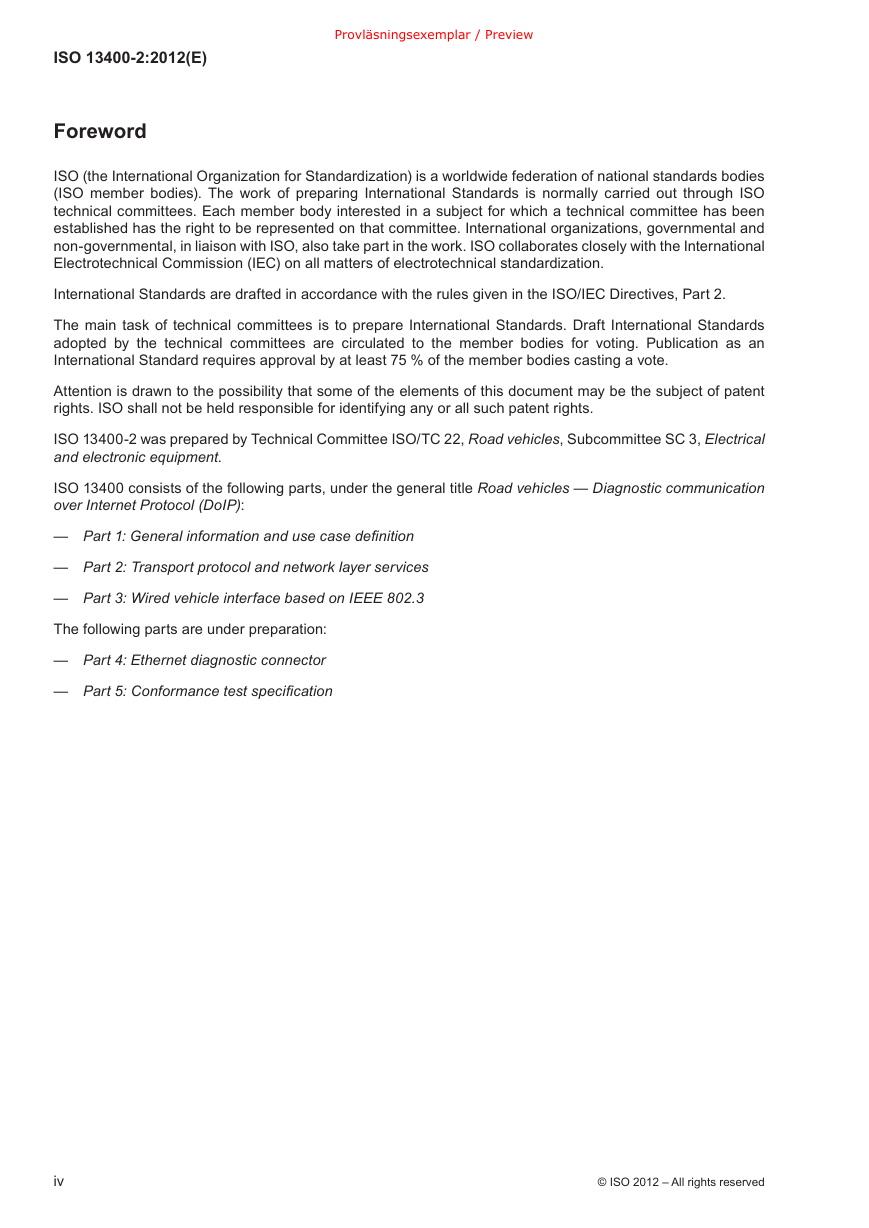
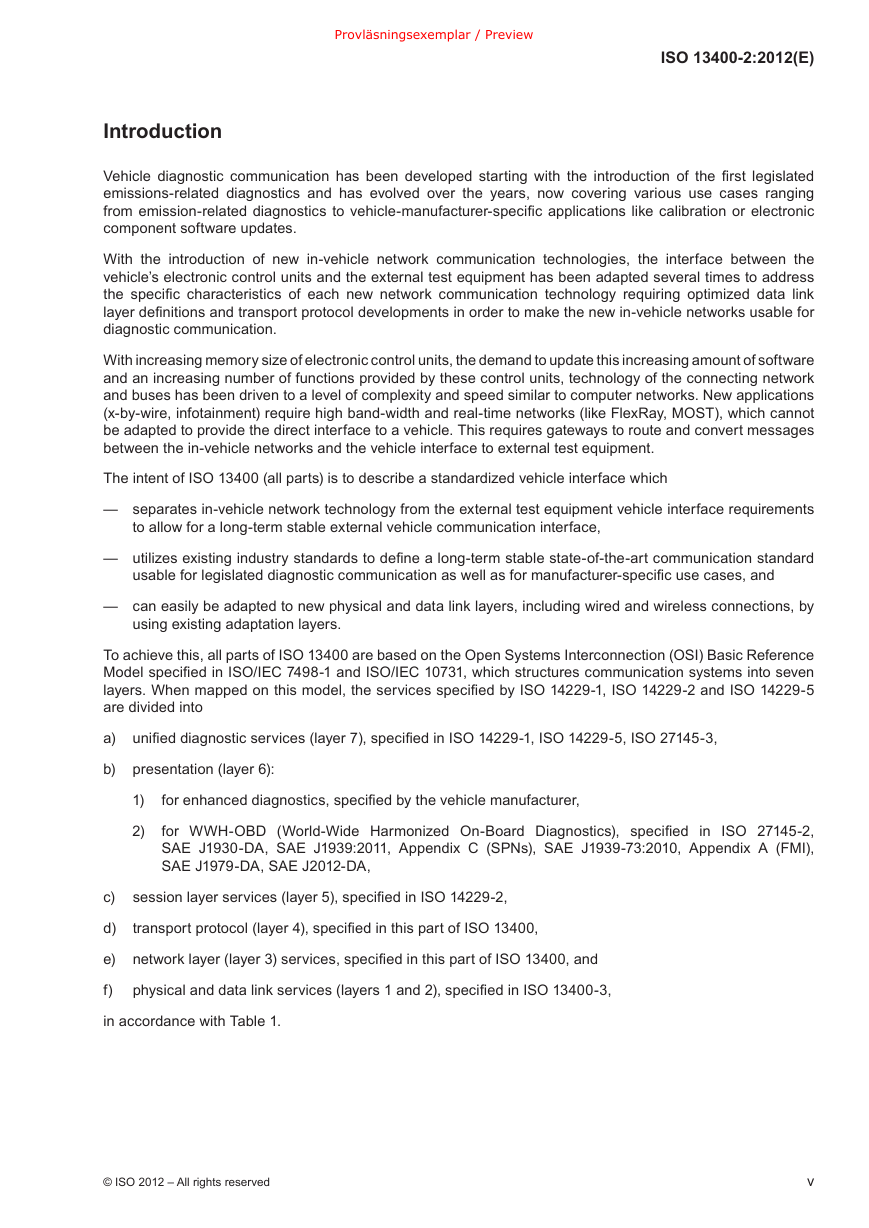
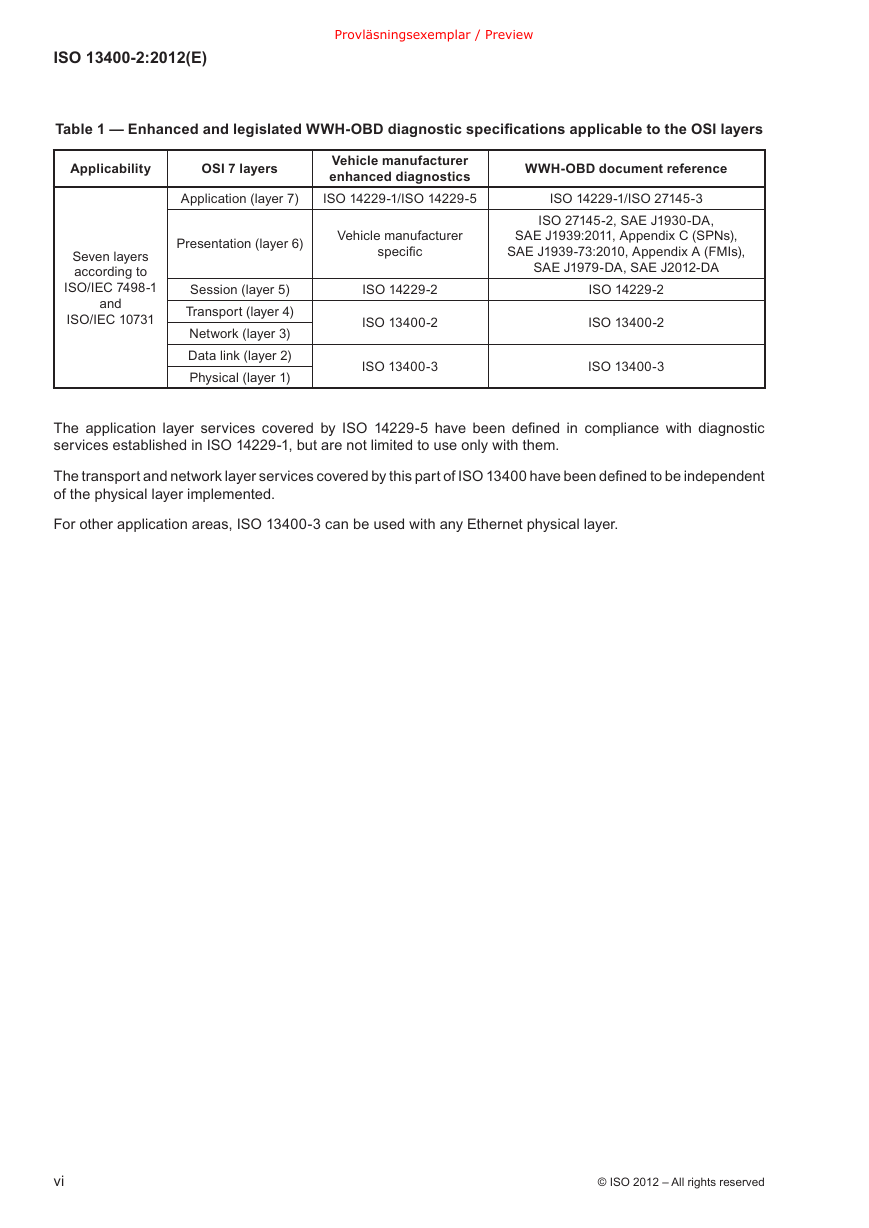
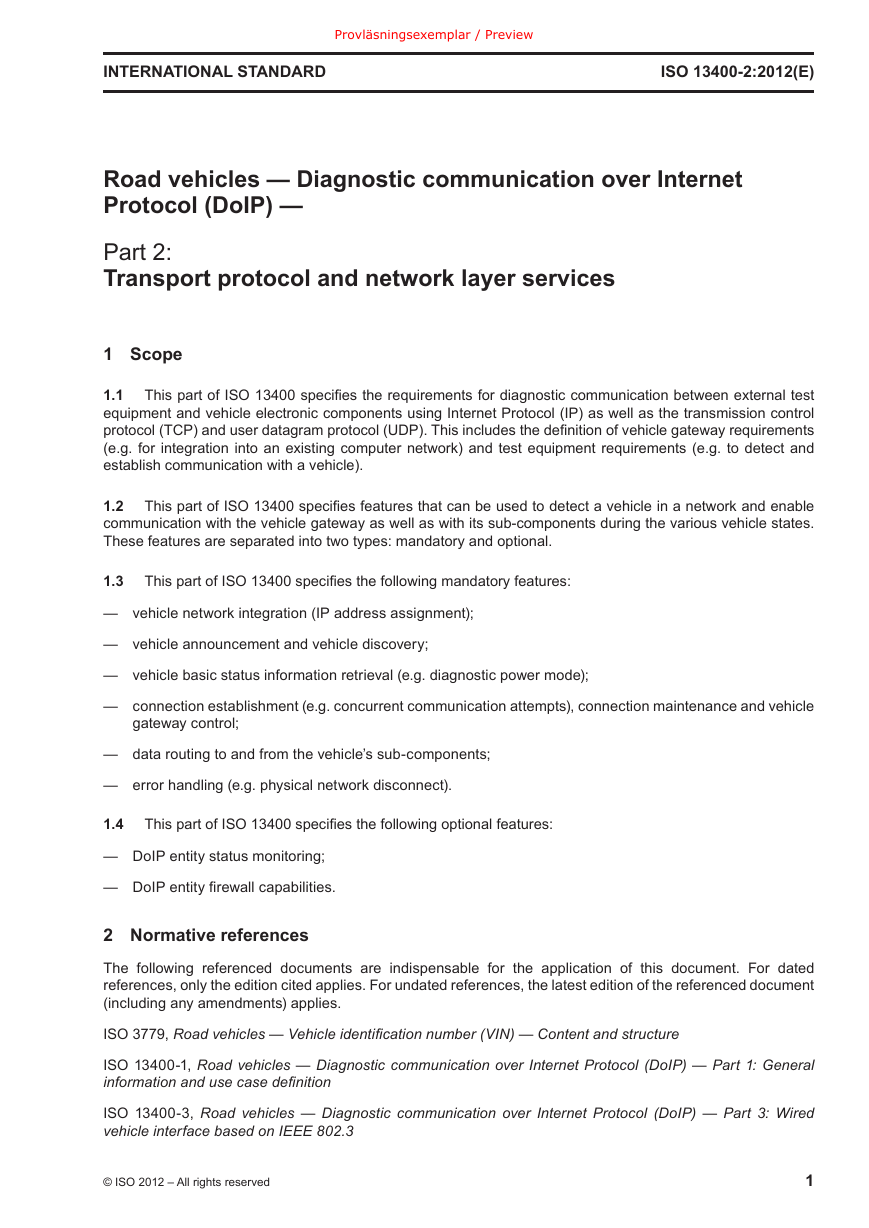
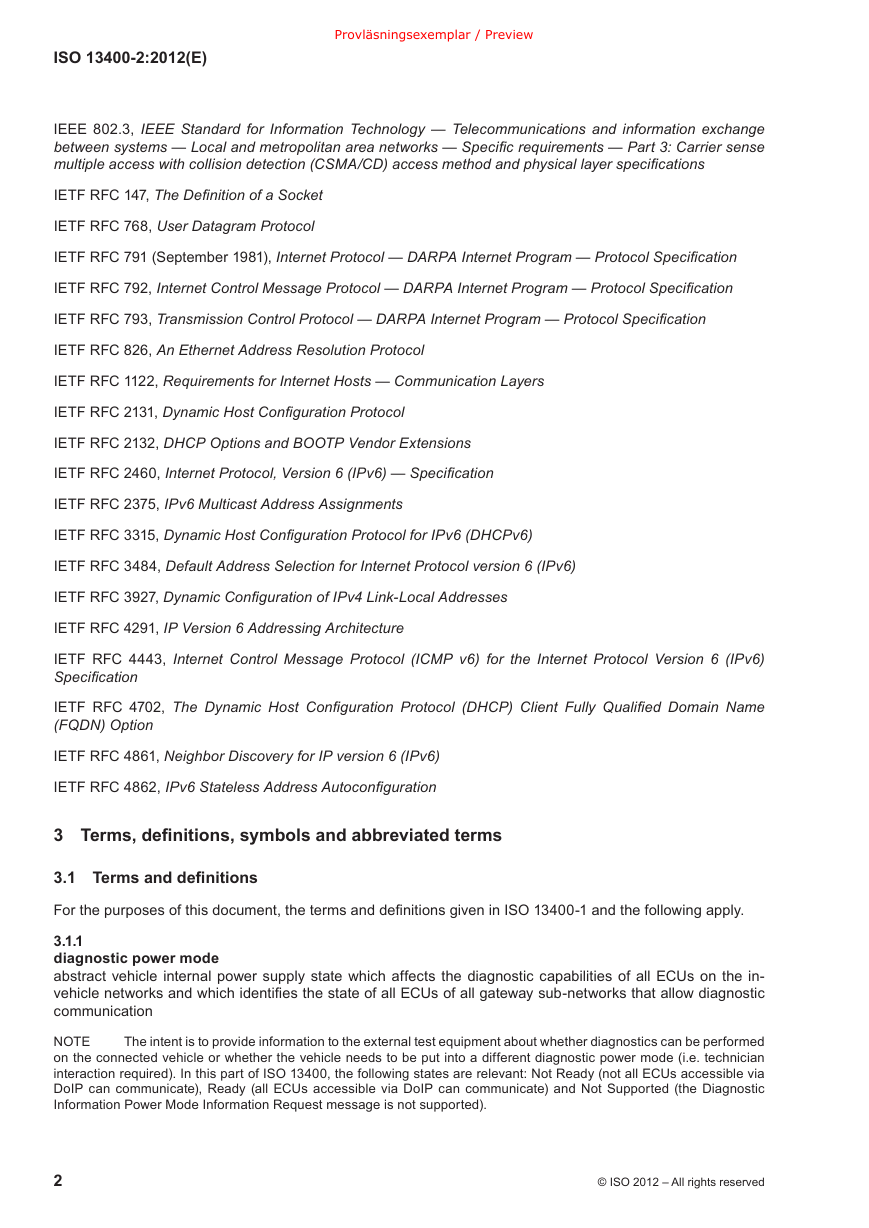








 2023年江西萍乡中考道德与法治真题及答案.doc
2023年江西萍乡中考道德与法治真题及答案.doc 2012年重庆南川中考生物真题及答案.doc
2012年重庆南川中考生物真题及答案.doc 2013年江西师范大学地理学综合及文艺理论基础考研真题.doc
2013年江西师范大学地理学综合及文艺理论基础考研真题.doc 2020年四川甘孜小升初语文真题及答案I卷.doc
2020年四川甘孜小升初语文真题及答案I卷.doc 2020年注册岩土工程师专业基础考试真题及答案.doc
2020年注册岩土工程师专业基础考试真题及答案.doc 2023-2024学年福建省厦门市九年级上学期数学月考试题及答案.doc
2023-2024学年福建省厦门市九年级上学期数学月考试题及答案.doc 2021-2022学年辽宁省沈阳市大东区九年级上学期语文期末试题及答案.doc
2021-2022学年辽宁省沈阳市大东区九年级上学期语文期末试题及答案.doc 2022-2023学年北京东城区初三第一学期物理期末试卷及答案.doc
2022-2023学年北京东城区初三第一学期物理期末试卷及答案.doc 2018上半年江西教师资格初中地理学科知识与教学能力真题及答案.doc
2018上半年江西教师资格初中地理学科知识与教学能力真题及答案.doc 2012年河北国家公务员申论考试真题及答案-省级.doc
2012年河北国家公务员申论考试真题及答案-省级.doc 2020-2021学年江苏省扬州市江都区邵樊片九年级上学期数学第一次质量检测试题及答案.doc
2020-2021学年江苏省扬州市江都区邵樊片九年级上学期数学第一次质量检测试题及答案.doc 2022下半年黑龙江教师资格证中学综合素质真题及答案.doc
2022下半年黑龙江教师资格证中学综合素质真题及答案.doc